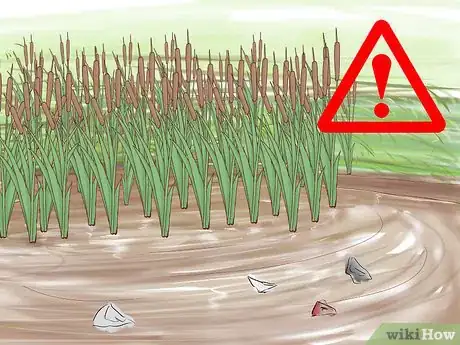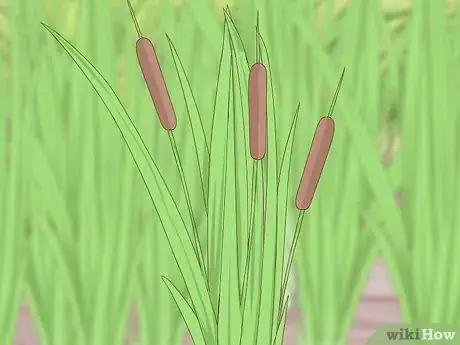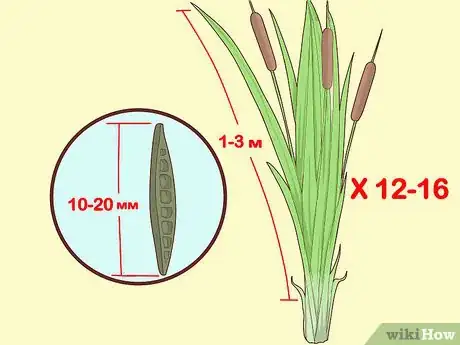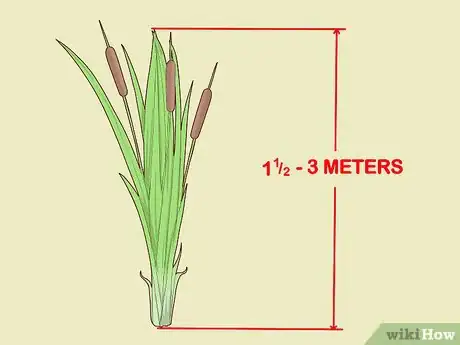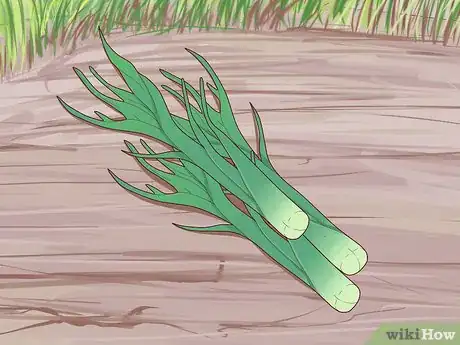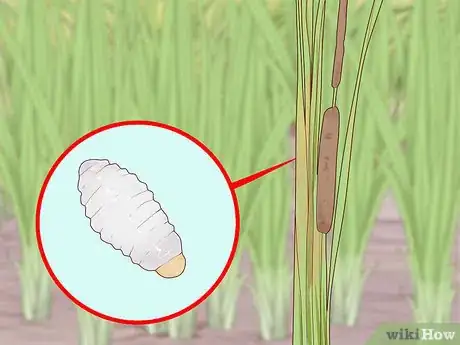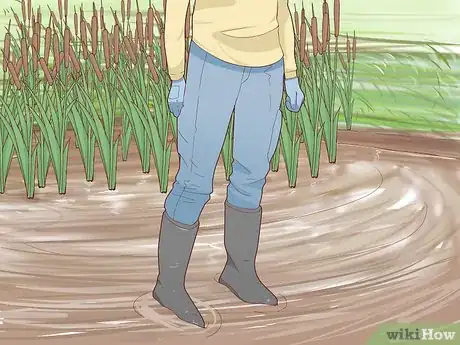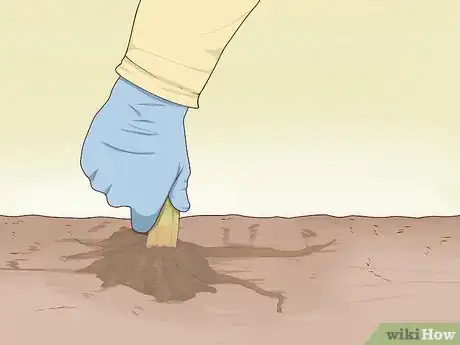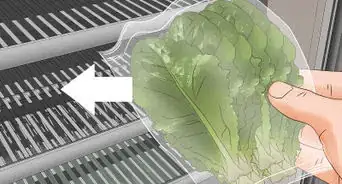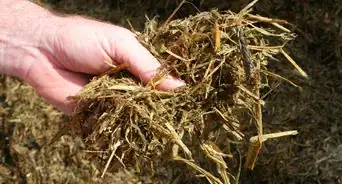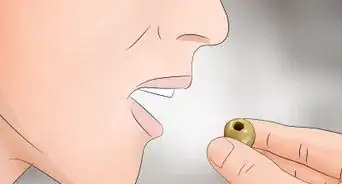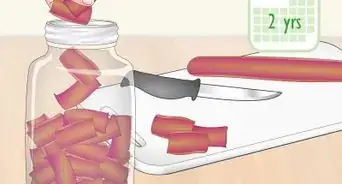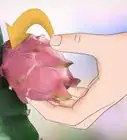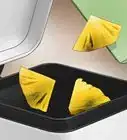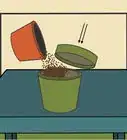This article was co-authored by Lauren Kurtz. Lauren Kurtz is a Naturalist and Horticultural Specialist. Lauren has worked for Aurora, Colorado managing the Water-Wise Garden at Aurora Municipal Center for the Water Conservation Department. She earned a BA in Environmental and Sustainability Studies from Western Michigan University in 2014.
This article has been viewed 22,844 times.
Cattails (Typha) are one of the best survival foods. The roots can be dried and turned into flour. The leaves can be used for salads, the stems can be boiled and the flowers can be roasted.[1] You can even dry their spikes to make torches and weave baskets out of their fibers. They are extremely productive in terms of flour production, with one acre of cattails potentially producing 6,475 pounds of flour.[2] The roots are best harvested in the winter, whereas the shoots are freshest in the spring and early summer.[3]
Steps
Searching for Cattails
-
1
-
2Avoid harvesting cattails from polluted areas. If you are foraging for cattails to eat, you should avoid collecting them from heavily polluted roadsides, as well as bioswales and other areas that are likely contaminated.[6] Cattails are increasingly used for the purpose of cleaning contaminated wetlands, such as areas where there is industrial pollution and dangerous chemicals like arsenic.[7]
- You should exercise caution wherever it looks like the plants may have been planted with the purpose of remediating a polluted area.[8]
- Avoid picking cattails from ponds in urban or suburban developments. Cattails are often planted in order to help clean the contaminated water from the development. You should avoid eating these cattails, since they will have accumulated toxins.[9]
- If you are harvesting the cattails to make rope, however, it is fine to collect them from these areas.
Advertisement -
3Notice the “hot dog” shape on the top of the plant. Cattails have a memorable shape that may remind you of eating hot dogs on a stick at summer camp. The flower head is brown and looks like a hot dog.[10] Some people describe the flower head as a large cigar. These flower heads contain thousands of seeds.[11]
-
4Look at the thick, linear leaves. The leaves are long and flat, typically measuring one to three metres in length. You will see twelve to sixteen leaves on each cattail shoot. The cross section of a leaf is D-shaped and between ten and twenty millimeters in width.[12]
-
5Check out the height of cattails. This edible plant grows to between one and a half and three metres in height. They have a seed pod on the top that looks like a cigar or a hot dog.[13]
-
6Check out the spikes. The spikes or young shoots of a cattail plant look like large leaks. If you get up close to a bunch of cattails, you will notice the young spikes poking just below or above the water line.[14]
-
7Inspect the brown leaf and the beetle grub. Look for a leaf that is slightly brown where it meets the stalk. Often, you will find the beetle grub hiding inside this leaf. You can use it as bait for fishing.[15]
Pulling up the Cattails
-
1Put on your gloves and boots. Walk out into the marshy crop of cattails. Since cattails grow in wet, marshy areas, you may want to wear rainboots or waders. You could also go barefooted, although you should assess risks like cutting your feet on broken glass. Gloves are also a good idea, since you will be working in the muck.
- If you go barefoot, it might be a bit cold.
- A risk of going barefoot is cutting your feet on bottles, rocks or other sharp objects.
- If you go barefoot, you could easily sprain your ankle on one of the plants.
- Ticks and leaches are a concern in some areas and seasons. If it is tick season, you should definitely avoid going barefoot.
-
2Locate the roots. The roots or “rhizomes” of the plant need to be loosened up, but first you need to find them. Use your hands to follow the stalk or shoot of the plant until you get to the base of the plant, which will likely be in the mud. Feel for one of the branches of the root system.[16]
-
3Loosen up the roots. Get a grip on the roots of the cattail. Pull and push the roots until you feel the plant loosen up a bit in the mud.
-
4Pull up the cattail. Hold onto the base of the plant. Pull upwards with all of your strength to remove the cattail. Try to remove as much of the root system as you can.
Community Q&A
-
QuestionAfter picking a cattail, will the flower eventually turn to fluff?
 Community AnswerIn my experience, yes. However, you could spray them with aerosol hair spray or any other type of setting spray (which you can find in craft stores) and that should prevent this from happening.
Community AnswerIn my experience, yes. However, you could spray them with aerosol hair spray or any other type of setting spray (which you can find in craft stores) and that should prevent this from happening.
Warnings
- Do not eat unwashed cattail. If the body of water where the cattail was growing is infected with microbes or parasites, you may get sick.[17]⧼thumbs_response⧽
- Don’t eat cattails that are collected from bioswales.⧼thumbs_response⧽
- Don’t eat cattails that were planted for the purpose of remediating contaminated wetlands.⧼thumbs_response⧽
- Always ask for permission before harvesting cattail on someone's private property.⧼thumbs_response⧽
References
- ↑ http://www.ediblewildfood.com/cattail.aspx
- ↑ http://www.eattheweeds.com/cattails-a-survival-dinner/
- ↑ http://www.offthegridnews.com/extreme-survival/cattails-how-to-safely-harvest-and-eat-natures-4-seasons-survival-plant/
- ↑ https://holeinthefence.net/tag/edible-parts-of-a-cattail/
- ↑ http://www.ediblewildfood.com/cattail.aspx
- ↑ http://www.wolfcollege.com/the-most-important-plant-cattails-video-of-finding-harvesting-transplanting-cooking-cattails/
- ↑ https://cleantechnica.com/2009/05/16/cattail-army-deployed-to-fight-water-pollution/
- ↑ https://cleantechnica.com/2009/05/16/cattail-army-deployed-to-fight-water-pollution/
- ↑ http://www.wolfcollege.com/the-most-important-plant-cattails-video-of-finding-harvesting-transplanting-cooking-cattails/
- ↑ https://holeinthefence.net/tag/edible-parts-of-a-cattail/
- ↑ http://www.ediblewildfood.com/cattail.aspx
- ↑ http://www.ediblewildfood.com/cattail.aspx
- ↑ http://www.ediblewildfood.com/cattail.aspx
- ↑ http://www.offthegridnews.com/extreme-survival/cattails-how-to-safely-harvest-and-eat-natures-4-seasons-survival-plant/
- ↑ http://www.eattheweeds.com/cattails-a-survival-dinner/
- ↑ https://holeinthefence.net/tag/edible-parts-of-a-cattail/
- ↑ http://www.offthegridnews.com/extreme-survival/cattails-how-to-safely-harvest-and-eat-natures-4-seasons-survival-plant/

